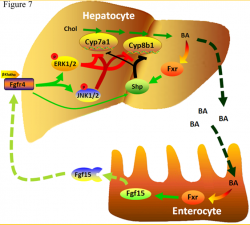Liver Disease
The liver is one the most vital organs of the body. One of its main jobs is to filter the blood coming from the stomach and intestines, before passing the blood to the rest of the body. The blood coming from the stomach and the intestines contains nutrients and chemical substances absorbed from digested food, water and medications, some of which can be toxic. Another major function of the liver is to produce bile acids, which help to remove extra cholesterol from the body and to aid in the absorption of fats and fat-soluble vitamins that are important to life, including vitamins A, D, E, and K.
Many drugs and environmental chemicals can increase bile acid production by the liver, leading to a severe liver disease called cholestasis, in which the flow of bile from the liver stops or slows. For thousands of years, the liver itself was thought to control the production of bile acids. During the last decade, our laboratory, together with other laboratories around the world, discovered that substances produced in the intestines play important roles in controlling bile acid balance in the liver. This ground-breaking discovery means that new medicines that affect the way the intestine controls bile acid production may help to lower blood cholesterol levels, or to treat or prevent cholestasis.
Model of Liver-Intestine Crosstalk for Regulating Bile-Acid Production
| Key |
| • Hepatocyte: liver cell • Enterocyte: small intestine cell • BA: Bile Acid • FXR: Farnesoid X Receptor |
Model of negative-feedback regulation of hepatic bile-acid synthesis by nuclear receptor Fxr in a tissue-specific manner. Bile acids in hepatocytes (liver cells)activate Fxr to induce Shp expression, which inhibited Lrh-1- and/or Hnf4?-induced gene transcription of Cyp7a1 and Cyp8b1, to mainly result in decreasing the expression of the Cyp8b1 gene and, to a minor extent, the Cyp7a1 gene. Bile acids in enterocytes activated Fxr to induce Fgf15 expression. Fgf15 is released into the circulation and is transported to the liver followed by binding to its cognate tyrosine kinase receptor (Fgfr4) and Fgfr4 coreceptor (?-Klotho) on hepatocyte cell membrane. Activation of Fgfr4 activated mainly ERK1/2 and, to a less extent, JNK1/2 to down-regulate both Cyp7a1 and Cyp8b1 gene expression. Furthermore, Shp appeared to be regulated by Fgf15/Fgfr4.
Next Steps:
Moving forward, it’s important to find or create drugs that change the activity of Farnesoid X Receptor (FXR) with the goal of preventing and treating fatty liver diseases.
Dr. Grace Guo is an Associate Professor at the Department of Pharmacology and Toxicology in the Ernest Mario School of Pharmacy of Rutgers University as well as a member of the Center for Environmental Exposure and Diseases (CEED).
Read the published research:
Kong B, Wang L, Chiang JY, Zhang Y, Klaassen CD, Guo GL. Mechanism of tissue-specific farnesoid x receptor in suppressing the expression of genes in bile-acid synthesis in mice. Hepatology 2012.56:1034-43. http://onlinelibrary.wiley.com/enhanced/doi/10.1002/hep.25740/
Funding:
This research was funded in part by the National Institute of Environmental Health Sciences (NIEHS) through the Center for Environmental Exposures and Disease at EOHSI (NIH-NIEHS P30 ES005022) and NIH R01GM104037
 |
 |




